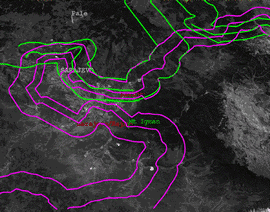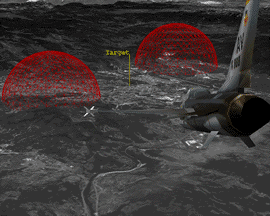|

|
NATO = hi-tech, rational, civilized |
|
Yugoslav forces = medieval, irrational,
barbaric |

PowerScene images used during
the Dayton Accords

|
CRA
Real World Applications - Powerscene
"Commanders know that
identifying problems is no longer sufficient; problems must
be seen to be solved. "
This is the digital mapping
program that U.S. government and Pentagon officials had Slobodan
Milosevic (Yugoslavia), Franjo Tudjman (Croatia), and Alija
Izetbegovic (Bosnia) play at an airforce base in Ohio to reach
the Dayton "peace" accords in 1995. Powerscene was
also used in NATO's Operation Deliberate Force in Bosnia in
1995. The Dayton agreement instituted the tripartite territorial
division of Bosnia into ethnically homogenized enclaves. The
u.s.-designed accords effectively legitimized ethnic partition
and the violent redrawing of borders through ethnic expulsions
in one of the most ethnically mixed areas in the region.
21
Days in Dayton
"WASHINGTON - The wine was drunk,
a lavish lobster dinner eaten, and it was time to resolve
one of the most delicate issues in the Bosnian peace talks:
the creation of a route for the Bosnian government from Sarajevo
through Bosnian-Serb territory to the beleaguered Muslim enclave
of Gorazde.
President Slobodan Milosevic of Serbia made his way to a high-tech
auditorium to play Powerscene, the Pentagon's computer mapping
program that reproduces terrain on a vast movie screen. The
Serbian leader was adamant that the corridor could be no more
than two miles wide.
Gen. Wesley K. Clark, the senior American military official
at the negotiations, whisked Milosevic off on an imaginary
aerial tour of the region to show why such a narrow corridor
made no strategic sense. "As you see, God did not put
the mountains two miles apart," Clark said.
Milosevic downed a large whisky, considered this geophysical
fact, and the deal on a five-mile-wide corridor was consummated.
It became known as the "Scotch Road." "
|
| Other Weapons Manufacturers & Defense
Contractors |
MojoWire's Resources on U.S.
Arms Sales Around the World
Jane's
Defense: "US Navy plans exotic weapons in ten years: High-powered
lasers that knock cruise missiles and aircraft out of the sky, precision-guided
projectiles that emerge from the exoatmosphere at a speed of M5.0,
striking their targets with such force that explosive warheads are
not required. These are some of the advanced technologies senior
US Navy (USN) officials believe will equipe future warships. "
Lockheed
Martin: one of the products advertised under Strike Weapons:
"The 2,000- pound BLU-109 is developed by Lockheed Martin to
defeat the enemy’s most critical and hardened targets, secure
command locations, and to protect weapon storage and key transportation
and communication resources. The BLU-109’s advanced technology
case penetrates the target intact to get to the interior of hardened
targets, where the warhead explodes, ensuring target destruction."
Evans
& Sutherland: visual imaging systems for defense and security
purposes
FlirSystems:
the global leader in infrared camera technology
MPRI:
MPRI is a semi-official Pentagon contractor headed by retired U.S.
military officers. It specializes in sending mercenary armies under
Pentagon contract into wars. The Pentagon contracted MPRI to organize
and train the croatian army to carry out the August 1995 offensive
known as Operation Storm that ethnically cleansed over 200,000 serbs
from the krajina region of croatia.
Military
Training Technology Online
|

